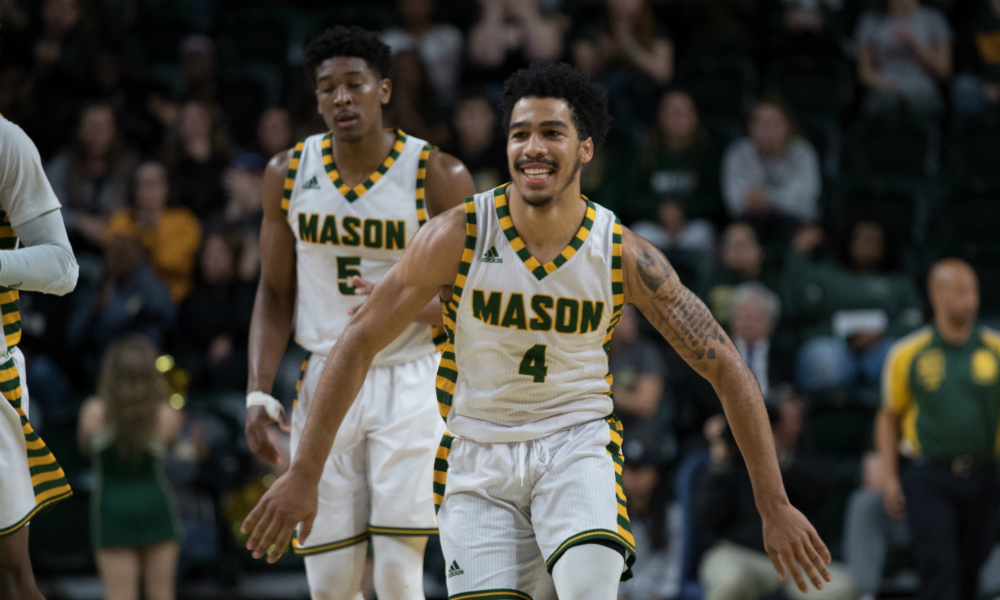Welcome back to the weekly rundown! This week in George Mason basketball brought us one loss to a very good St. Bonaventure team and one wonky win against a surprisingly good Richmond team. Per usual, we’ll be reviewing the good, the bad, and anything else that might be interesting. Let’s get to it.
In appreciation of Otis Livingston
This column oscillates between fawning over Otis for his career achievements or ignoring him because he’s so damn consistent that it’s more interesting to talk about other variables. This year, I think even the biggest homer Mason fans like myself might be underrating the job he’s doing of carrying the burden on offense.
Otis leads the team in scoring, but it’s how he gets there that’s unique. When you watch Mason play, it’s clear that Otis is the driving creative force, as he’s the only player who can consistently score at all three levels. It also becomes obvious that he’s isolated a lot, and he’s getting buckets as a result of either beating his man off the dribble or hitting tough step-back jumpers. He is generally not the beneficiary of shots that have been created for him, as many players are.
I wanted to dig through numbers to see if there’s anything to the thought that Otis is scoring in isolated sets more often than other comparable players. Using assist rates data from hoop-math.com, it turns out that this is easily quantifiable. In the table below I’ve cherry-picked some other A10 players by size, position, and workload in order to see how Otis’s assisted baskets (total field goals made by a player that were assisted) stacks up against other nominal point-guards or volume scorers. It’s a slim pool so these comparisons aren’t perfect, but I still think they’re illuminating. Check it out:
| Player | True Shooting % | Total FGM | Total assisted rate |
| Livingston II, Otis | 0.572 | 135 | 21.5% |
| Newkirk, Shavar | 0.489 | 111 | 23.4% |
| Powell, Pookie | 0.533 | 136 | 33.8% |
| Kier, Justin | 0.524 | 91 | 34.1% |
| Adams, Jaylen | 0.621 | 84 | 38.1% |
| Pipkins, Luwane | 0.557 | 167 | 40.1% |
| Matthews, E.C. | 0.558 | 77 | 41.6% |
| Bolden, Jair | 0.444 | 95 | 45.3% |
| Nolan Jr., Terry | 0.546 | 70 | 51.4% |
| Terrell, Jared | 0.597 | 132 | 53.0% |
| Roby, Davell | 0.528 | 76 | 64.5% |
Only 29 of Otis’s 135 field goals (21.5%) came as the result of an assist, the lowest I could find among comparable players. Shavar Newkirk is in Otis’s ballpark, but Newkirk’s true shooting percentage is .083 points lower, a massive drop-off. Newkirk is isolated a lot but he’s not scoring with anything close to Otis’s efficiency. Not only does Otis have the third highest true shooting percentage in the group, he’s also ten points behind the rest of the field (sans Newkirk) in his assisted buckets rate. There’s not a big group of volume scorers in the A10 that I’ve selectively left out of this sample; if you can find anyone in the A10 in the 15 points per game range with a lower assisted buckets rate I’d love to see it.
Just out of curiosity I did find a player with higher volume, a higher true shooting percentage, and a lower rate of assisted buckets. It’s the national player of the year:
| Player | True Shooting % | Total FGM | Total assisted rate |
| Young, Trae | 0.62 | 188 | 16.5% |
Javon Greene gets going
Greene has been getting plenty of minutes off the bench lately, but the production hasn’t always followed. Against Richmond he played his best game of the season, filling up the box score with a tremendous 14 point, 9 rebound, 6 steal, 3 assist, and 2 block effort. I suspect this might be partially due to Jaire Grayer’s absence – Javon doesn’t have an imperative to produce when Jaire is on the court doing a lot of those things, and he can get away with deferring creative responsibilities to teammates and lobbing 3s. Without Jaire, someone needed to fill the role of attacking guard who plays bigger than his size.
Javon has the potential to be the most devastating kind of guard – the physical, athletic kind that can impact games without scoring a point. He has the highest steal rate on the team and the highest rebounding and block rate of any Mason guard other than Jaire. He’s still struggling with the three, but he was 5-8 inside the arc against Richmond. On the season, he’s 17-22 at the rim but just 15-76 on jumpers and threes. A guard who is athletic enough to attack the rim consistently, grab rebounds, generate turnovers, and block shots can be a nightmare for opponents. Personally, I’d like to see Javon continue to develop all these elements of his game. If he fills up the box score like he did against Richmond, the points will follow and Mason will be more dangerous as a result.
Playing with pace
With around six minutes left in the Richmond game Mason clearly went from pushing the tempo and running the floor to taking the air out of the ball in an attempt to drain the clock. I disagreed with it at the time; Mason had built a double-digit lead because the accelerated pace was working in their favor. Save for a couple possessions, almost all of Mason’s looks down the stretch were contested, low percentage shots, a big part of the reason Mason went cold and Richmond caught back up.
If you feel like Mason plays a lot better up-tempo, you’re not wrong. Using data from hoop-math.com once again, we can see Mason’s splits by how early in the shot clock a shot is taken:
| Start of Poss | % of initial attempts | eFG% | % Shots at rim | FG% at rim | % Shots 2pt Jumpers | FG% 2pt Jumpers | % Shots 3pt | FG% 3pt | |
| Rebound, 0-10 s | 11.6% | 62.5% | 43.4% | 72.9% | 17.6% | 37.5% | 39.0% | 41.5% | |
| Rebound, 11-30 s | 24.5% | 50.2% | 25.7% | 59.5% | 36.5% | 45.7% | 37.8% | 32.1% | |
| Opp score, 0-10 s | 2.7% | 48.4% | 31.2% | 90.0% | 25.0% | 25.0% | 43.8% | 21.4% | |
| Opp score, 11-30 s | 42.4% | 45.9% | 23.6% | 53.4% | 34.7% | 40.5% | 41.7% | 30.8% | |
| Steal, 0-10 s | 7.0% | 65.9% | 63.4% | 75.0% | 14.6% | 25.0% | 22.0% | 44.4% | |
| Steal, 11-30 s | 2.3% | 29.6% | 22.2% | 66.7% | 37.0% | 10.0% | 40.7% | 18.2% | |
| Transition | 21.2% | 61.8% | 48.4% | 75.2% | 17.6% | 31.8% | 34.0% | 38.8% |
If you don’t feel like parsing all that, I’ll translate. Mason has an effective field goal percentage (eFG) of 61.8% when shooting in the first ten seconds of the shot clock. That’s the 36th best rate in the entire country. Mason’s eFG in non-transition opportunities (defined as shots taken after 11-30 seconds) is 46.6%, 304th in the NCAA. Put simply, Mason is one of the most effective teams in the country when pushing the pace and one of the least effective teams in the country slowing it down. Mason shoots 38.8% from three in transition (vs 32% overall), including 41.5% off rebounds and 44.4% off steals.
There’s plenty of evidence that running is where Mason is most dangerous and slowing it down plays into the opponent’s hands. Of course efficiency would go down if Mason pushed the tempo nonstop, but there’s such a wide disparity between transition performance and halfcourt performance that it’s not worth worrying about.
Some parting thoughts:
- Greg Calixte did a fantastic job guarding Grant Golden and was a big part of the reason he was held to 5-18 shooting. Golden is a tremendously skilled player but not a very physical one. His game is mostly finesse at this point and Greg did a great job chipping him and making him uncomfortable. The big man continues to make strides.
- In the VCU game Jaire had 13 rebounds and no other Patriot had more than 3. Against Richmond, Calixte, Kier, Greene, and Goanar all had 9 rebounds. Richmond is the rare team that’s smaller than Mason, so I don’t expect that to continue, but it was good to see a total team rebounding effort.
- Quick shout-out to incoming Mason recruit Jason Douglas-Stanley for setting Mount Vernon High School’s single-game scoring record with a 50 point outburst this week. Mount Vernon is the home of Mason 1,500 point scorer Sherrod Wright, former UConn great and #3 overall draft pick Ben Gordon, and eight others who have gone on to play in the NBA. Setting a scoring record at a school like that is quite an accomplishment and I can’t wait to see him in the green and gold.
- The next two games are crucial for Mason’s seeding in the A10 tournament. Right now Mason is two games clear of the play-in game, but the two teams in the PIG are the opponents this week. Wins over 2-8 A10 bottom-feeders Fordham and George Washington would put Mason at 6-6 and make 8 or 9 conference wins very reasonable; losses would drop Mason to 4-8 and suddenly right back into the fight to stay out of the PIG. The way this team runs hot and cold either result is possible.
- EDIT: A reader (what’s up Alan) pointed out that there are two play-in-games, not one. That means Mason has to finish in the top ten, not just the top twelve, to stay out of a PIG. A fireable oversight on my part. The official A10 standings page shows Mason in 9th place, but at 4-6 that’s tied record-wise with 11th place St. Joseph’s. We won’t worry about tiebreakers just yet, but beating Fordham and GW this week is imperative. It’s tough to see a path out of the PIG if Mason even splits those games.
That’s it for this week. Check back next week for more updates. Go Mason!










